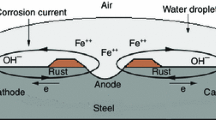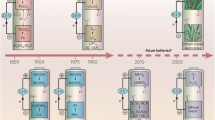Abstract
The current exploration emphasizes improving the solubility and thermal characteristics of the homopolymers–polyaniline and poly-2-aminophenol via copolymerization technique with simultaneous optimization of conductivity and dielectric behavior. Poly (aniline-co-2-aminophenol) copolymers with varying monomers compositions have been synthesized using chemical oxidative copolymerization technique. The copolymers showed considerable improvement of solubility in organic solvent compared to the unsubstituted polyaniline. Morphology of these copolymers was characterized by powdered-XRD and FESEM measurements. The studies revealed improved crystallinity in the copolymers compared to poly-2-aminophenol homopolymer. All the copolymers possess porous network with different degrees of aggregated nanoparticles blended with nanoflake structures. The copolymers also exhibited appreciable thermal stability over the homopolymers inferred from DSC measurements. The variation of frequency-dependent conductivity and dielectric permittivity of these different copolymers were further investigated and correlated with grain size distribution and varying proportions of oligoaniline segments in the polymer backbone of poly-2-aminophenol.







Similar content being viewed by others
References
Sherman BC, Euler WB, Force RR (1994) The modern student laboratory: polyaniline-A conducting polymer: electrochemical synthesis and electrochromic properties. J Chem Educ 71:A94
Huang WS, Humphrey BD, MacDiarmid AG (1986) Polyaniline, a novel conducting polymer: morphology and chemistry of its oxidation and reduction in aqueous electrolytes. J Chem Soc Faraday Trans 1 82:2385–2400
Macdiarmid AG, Chiang JC, Richter AF, Epstein AJ (1987) Polyaniline: a new concept in conducting polymers. Synth Met 18:285–290
Tang H, Kumar P, Zhang S, Yi Z, Crescenzo GD, Santato C, Soavi F, Cicoira F (2015) Conducting polymer transistors making use of activated carbon gate electrodes. ACS Appl Mater Interfaces 7:969–973
Zou Y, Sun LX, Xu F (2007) Biosensor based on polyaniline–Prussian blue/multi-walled carbon nanotubes hybrid composites. Biosens Bioelectron 22:2669–2674
Kuo CT, Chiou W (1997) Field-effect transistor with polyaniline thin film as semiconductor. Synth Met 88:23–30
Ye S, Guihua Y (2016) Designing hierarchically nanostructured conductive polymer gels for electrochemical energy storage and conversion. Chem Mater 28:2466–2477
Green RA, Lovell NH, Wallace GG, Poole-Warren LA (2008) Conducting polymers for neural interfaces: challenges in developing an effective long-term implant. Biomaterials 29:3393–3399
Saini P, Arora M (2012) Microwave absorption and EMI shielding behavior of nanocomposites based on intrinsically conducting polymers. Graphene Carbon Nanotub. https://doi.org/10.5772/48779
Tan Shuxin, Zhai Jin, Xue Bofei, Wan Meixiang, Meng Qingbo, Li Yuliang, Jiang Lei, Zhu Daoben (2004) Property influence of polyanilines on photovoltaic behaviors of dye-sensitized solar cells. Langmuir 20(7):2934–2937
Boeva Z, Sergeyev V (2014) Polyaniline: synthesis, properties, and application. Polym Sci Ser C. https://doi.org/10.1134/S1811238214010032
Huang W-S, Humphrey BD, MacDiarmid AG (1986) Polyaniline, a novel conducting polymer: morphology and chemistry of its oxidation and reduction in aqueous electrolytes. J Chem Soc, Faraday Trans 1(82):2385–2400
Molapo KM, Ndangili PM, Ajayi RF, Mbambisa G, Mailu SM, Njomo N, Masikini M, Baker P, Iwuoha EI (2012) Electronics of conjugated polymers (I): polyaniline. Int J Electrochem Sci 7:11859–11875
Jousseaume V, Morsli M, Bonnet A (2000) Aging of electrical conductivity in conducting polymer films based on polyaniline. J Appl Phys 88:960
Murat A, Okan K (2014) Comparison of anticorrosion behavior of polyaniline and poly(3,4-methylenedioxyaniline) and their titanium dioxide nanocomposites. High Perform Polym 27(6):685–693
Jacob T, Joung EY, Joseph DT, Jeffrey S, Yueh-Lin L (2009) Polymer acid doped polyaniline is electrochemically stable beyond pH 9. Chem Mater 21(2):280–286
Mikhael MG, Padias AB, Hall HK (1997) N-alkylation and N-acylation of polyaniline and its effect on solubility and electrical conductivity. J Polym Sci A 35:1673
Moon GH, Sung WB, Seung S (2002) Thermal stability study of conductive polyaniline/polyimide blend films on their conductivity and ESR measurement. Polym Adv Technol 13:320–328
Waware US, Hamouda AMS, Hameed AS, Summers GJ (2017) Tuning the electrical properties of polyaniline by copolymerization with o-bromoaniline. Funct Mater Lett 10(4):1750039
Zhang Y, Qin L, Li S, Jianping Z (2009) The electrocatalytic reduction and removal of arsenate by poly(aniline-co-o-aminophenol). J Electroanal Chem 636:47–52
Xiu-Y H, Qing-Xin L, Maa Di, Zhong L, Yong K, Huai-Guo X (2015) One-step synthesis of MnO2 doped poly(aniline-co-o-aminophenol)and the capacitive behaviors of the conducting copolymer. Chin Chem Lett 26:1367–1370
Waware US, Hamouda AMS, Hameed AS, Mohd R, Summers GJ (2017) The spectral and morphological studies of the conductive polyaniline thin film derivatives by the in situ copolymerization. J Mater Sci: Mater Electron 28:15178–15183
Ozkan SZ, Eremeev GP, Karpacheva TN Prudskova, Veselova EV, Bondarenko GN, Shandryuk GA (2013) Polymers of diphenylamine-2-carboxylic acid: synthesis, structure, and properties. Polym Sci Ser B 55:107
Shaolin Mu (2004) Electrochemical copolymerization of aniline and o-aminophenol. Synth Met 143:259–268
Anwar-ul-Haq Ali Shah, Holze Rudolf (2006) Spectroelectrochemistry of aniline-o-aminophenol copolymers. Electrochim Acta 52:1374–1382
Yiting Xu, Dai Lizong, Chen Jiangfeng, Gal Jean-Yves, Huihuang Wu (2007) Synthesis and characterization of aniline and aniline-o-sulfonic acid copolymers. Eur Polym J 43:2072–2079
Liu Meiling, Ye Min, Yang Qin, Zhang Youyu, Xie Qingji, Yao Shouzhuo (2006) New method for characterizing the growth and properties of polyaniline and poly(aniline-co-o-aminophenol) films with the combination of EQCM and in situ FTIR spectroelectrochemistry. Electrochim Acta 52:342–352
Tzou K, Gregory RV (1993) A method to prepare soluble polyaniline salt solutions—in situ doping of PANI base with organic dopants in polar solvents. Synth Met 53(3):365–377
Ameen S, Ali V, Zulfequar M, Haq MM, Husain M (2007) Electrical conductivity and dielectric properties of sulfamic acid doped polyaniline. Curr Appl Phys 7(2):215–219
Inzelt G (2018) Conducting polymers: past, present, future. J Electrochem Sci Eng 8(1):3–37
Das TK, Prusty S (2012) Review on conducting polymers and their applications. Polym-Plast Technol Eng 51(14):1487–1500
Saafan SA, El-Nimr MK, El-Ghazzawy EH (2006) Study of dielectric properties of polypyrrole prepared using two different oxidizing agents. J Appl Polym Sci 99(6):3370–3379
Chao D, Jia X, Liu H, He L, Cui L, Wang C, Berda EB (2011) Novel electroactive poly(arylene ether sulfone) copolymers containing pendant oligoaniline groups: synthesis and properties. J Polym Sci, Part A: Polym Chem 49:1605–1614
Singh R, Arora V, Tandon RP, Mansingh A, Chandra S (1999) Dielectric spectroscopy of doped polyaniline. Synth Met 104(2):137–144
MacDiarmid AG, Epstein AJ (1994) The concept of secondary doping as applied to polyaniline. Synth Met 65:103–116
Islam S, Lakshmi GBVS, Siddiqui AM, Husain M, Zulfequar M (2013) Synthesis, electrical conductivity, and dielectric behavior of polyaniline/V2O5 composites. Int J Polym Sci. https://doi.org/10.1155/2013/307525
Mezdour D (2017) Dielectric properties of polyaniline composites. Spectrosc Lett 50(4):214–219
John H, Thomas RM, Mathew KT, Joseph R (2004) Studies on the dielectric properties of poly(o-toluidine) and poly(o-toluidine-aniline) copolymer. J Appl Polym Sci 92:592–598
Kumar D (2000) Synthesis and characterization of poly(aniline-co-o-toluidine) copolymer. Synth Met 114(3):369–372
Yang Y, Mu S (2008) Synthesis and high electrochemical activity of poly(aniline-co-2-amino-4-hydroxybenzenesulfonic acid). Electrochim Acta 54(2):506–512
Zhang J, Shan D, Mu S (2007) Chemical synthesis and electric properties of the conducting copolymer of aniline and o-aminophenol. J Polym Sci, Part A: Polym Chem 45:5573–5582
Hichem Z, Saad L, Yasmine M, Tarik HA (2015) Preparation and characterization of a new polyaniline salt with good conductivity and great solubility in dimethyl sulphoxide. J Serb Chem Soc 80(11):1435–1448
Zhang J, Shan D, Mu S (2007) A promising copolymer of aniline and m-aminophenol: chemical preparation, novel electric properties and characterization. Polymer 48:1269–1275
Gupta N, Kumar D, Tomar SK (2012) Thermal behaviour of chemically synthesized polyanilines/polystyrene sulphonic acid composites. Int J Mater Chem 2(2):79–85
Kumar D, Chandra R (2001) Thermal properties of synthetic metals: polyanilines. Ind J Eng Mater Sci 8:209–214
Pantery S, Stevens R, Bower CR (2005) The frequency dependent permittivity and AC conductivity of random electrical networks. Ferroelectrics 319:199–208
Vellakkat M, Archana K, Raghu S, Sharanappa C, Hundekal D (2014) Dielectric constant and transport mechanism of percolated polyaniline nanoclay composites. Ind Eng Chem Res 53:16873–16882
Saafan SA, El-Nimr MK, El-Ghazzawy EH (2006) Study of dielectric properties of polypyrrole prepared using two different oxidizing agents. J Appl Polym Sci 99:3370
Chutia P, Kumar A (2014) Electrical, optical and dielectric properties of HCl doped polyaniline nanorods. Phys B 436:200–207
Bekri-Abbes I, Srasra E (2015) Electrical and dielectric properties of polyaniline and polyaniline/montmorillonite nanocomposite prepared by solid reaction using spectroscopy impedance. J Nanomater 16(1):428
Brebels J, Manca J, Lutsen L, Vanderzande D, Maes W (2017) High dielectric constant conjugated materials for organic photovoltaics. J Mater Chem A 5:24037–24050
Rouis A, Davenas J, Bonnamour I, Ouada HB (2015) Studies of morphological optical and electrical properties of the MEH-PPV/azo-calix[4]arene composite layers. Phys B 474:70–76
Ahmed K, Kanwal F, Ramay SM, Mahmood A, Atiq S, Al-Zaghayer YS (2016) High dielectric constant study of TiO2-polypyrrole composites with low contents of filler prepared by in situ polymerization. Adv Condens Matter Phys 5:2. https://doi.org/10.1155/2016/4793434
Rizvi TZ, Shakoor A (2009) Electrical conductivity and dielectric properties of polypyrrole/Na+–montmorillonite (PPy/Na+–MMT) clay nanocomposites. J Phys D Appl Phys 42:095415
Madakbaş S, Çakmakçı E, Kahraman M, Esmer K (2013) Preparation, characterisation, and dielectric properties of polypyrrole-clay composites. Chem Pap 67(8):1048–1053
Acknowledgement
The authors are thankful to the Qatar University. Also, DM acknowledges Chandernagore College, Hooghly, WB, India, and Barasat Govt. College, Barasat, Kolkata, WB, India, for research supports.
Author information
Authors and Affiliations
Corresponding authors
Additional information
Publisher's Note
Springer Nature remains neutral with regard to jurisdictional claims in published maps and institutional affiliations.
Dipanwita Majumdar: Formerly at Department of Chemistry, Barasat Govt. College, Barasat, West Bengal, 700124 India.
Rights and permissions
About this article
Cite this article
Waware, U.S., Hamouda, A.M.S. & Majumdar, D. Optimization of physicochemical and dielectric features in the conductive copolymers of aniline and 2-aminophenol. Polym. Bull. 76, 5603–5617 (2019). https://doi.org/10.1007/s00289-018-2668-4
Received:
Revised:
Accepted:
Published:
Issue Date:
DOI: https://doi.org/10.1007/s00289-018-2668-4




